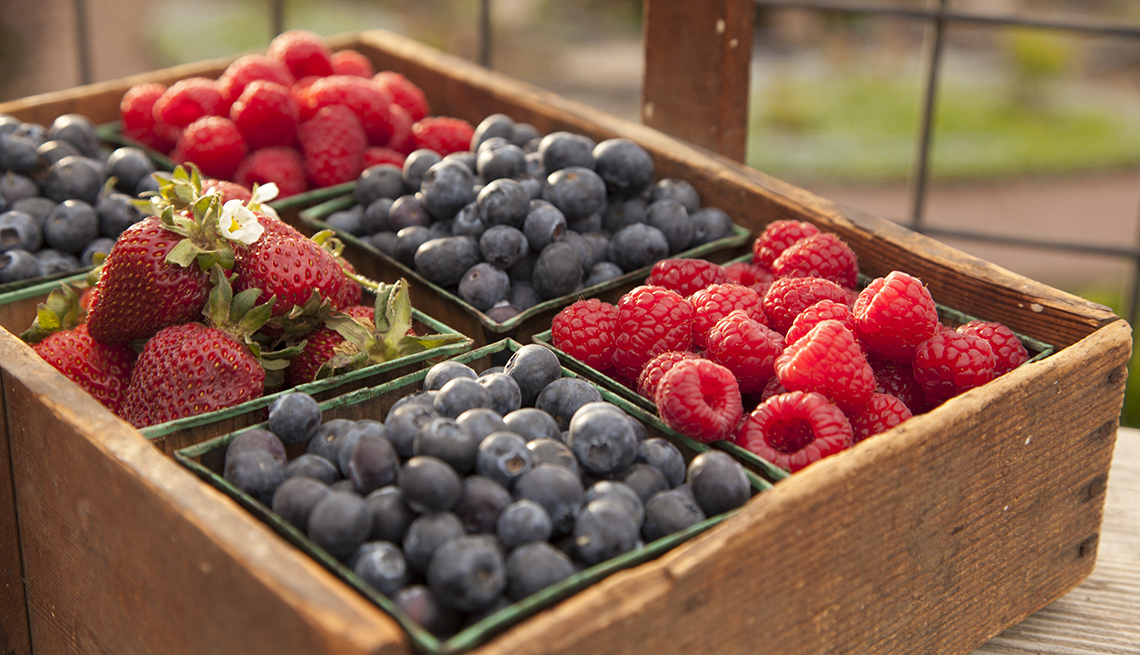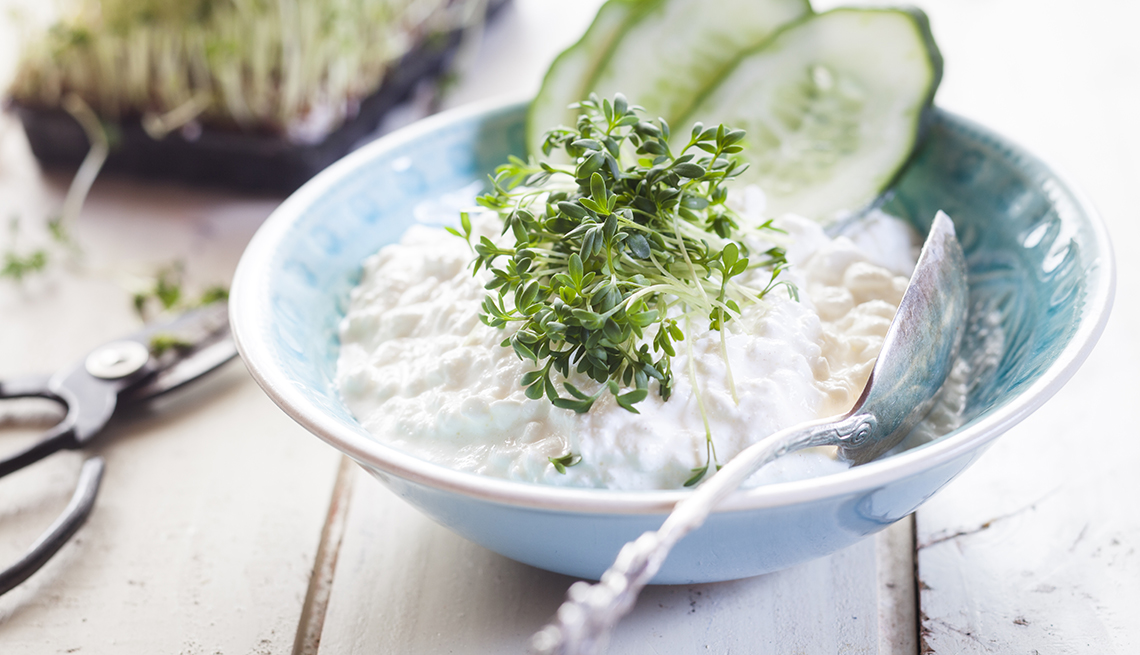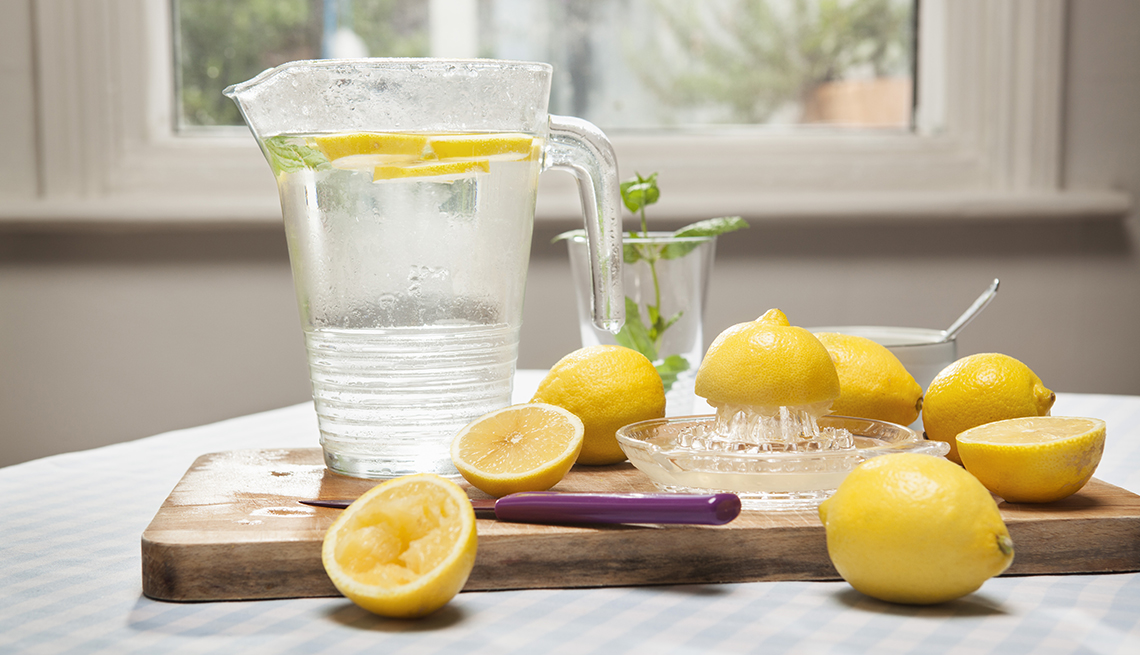Whether you've been a healthy eater your whole life — or lately fallen off the nutritional wagon — it's important to take a hard look at your diet after age 50. Around that point, experts say, it pays to be choosier about your foods, and make sure you're getting enough nutritional bang for your buck. “Our need for energy declines starting in middle age,” says Christine Rosenbloom, registered dietitian and nutritionist, professor emerita at Georgia State University and coauthor of Food & Fitness Over 50. “There's less room for drinking a pitcher of margaritas and having a basket of chips — unless we want to start seeing that weight creep. And nobody wants that.”
Beyond adapting to a potentially slower metabolism, you also want to compensate for things like a tendency for bones to weaken, bowel function to slow and muscle mass to decline (around 1 percent a year until age 65, after which the loss can double.) In general, older adults “need to make sure they're getting lots of fruits and vegetables, eating lean meats if they are eating meat, chicken or fish, and avoiding saturated fats and sugars,” says Marie Bernard, M.D., deputy director of the National Institute on Aging (NIA) and NIA's senior geriatrician. “A good diet can help get blood pressure under better control, decrease the risk of heart problems and contribute to the prevention of things like diabetes and cancer."
To build your own healthy diet, remember that “foods work together in concert,” says Joseph Gonzales, a registered dietitian at the Mayo Clinic. “You need a whole symphony for a spectacular musical piece.” But if you add these seven foods to your own orchestra, you're well on your way to a healthier tune.
1. Berries
Berries provide “one-stop nutrition” for the over-50 crowd because they're high in fiber, vitamin C and anti-inflammatory, antioxidant flavonoids. “Fiber helps keep us regular, manage our weight and protect against diseases like diabetes, heart disease and cancer,” says registered dietitian nutritionist Nancy Farrell Allen, a spokesperson for the Academy of Nutrition and Dietetics. Men 51 or older should eat 30 grams a day, and women 50 years or older should eat 21 grams a day.
Berries also appear to be good for our aging brains. “Berries contain potent antioxidants that may improve motor skills and short-term memory,” Allen says. That's why they are a key part of the MIND diet, which focuses on foods that fight neurodegenerative delay. (Other “brain-healthy foods from this brain-healthy diet include vegetables, beans, whole grains, nuts, seafood and poultry.) A Tufts University study from last year looked at 20 years of eating by 2,800 people age 50 or older and found that those who had a low intake of flavonoid-rich foods like berries, apples and tea were two to four times more likely to develop dementia.
Save 25% when you join AARP and enroll in Automatic Renewal for the first year. Get instant access to discounts, programs, services, and the information you need to benefit every area of your life.
Alicia Arbaje, M.D., associate professor of medicine at the Johns Hopkins School of Medicine in the Division of Geriatric Medicine and Gerontology, singles out the wild blueberry (usually sold in the frozen food section). “They have three or four times the antioxidants of conventional blueberries. Add them to your oatmeal or smoothies."
2. Dark-green leafy vegetables
"As we get older, our bones become softer and need calcium,” says Bernard of the NIA. “That's something you can get from low-fat dairy and dark-green leafy vegetables.” We're talking kale, arugula, broccoli and spinach, which are also high in fiber, appear to boost muscle function and are heart-healthy. An Australian study published in March in the Journal of Nutrition found that people who ate just one cup of nitrate-rich leafy green vegetables every day had 11 percent stronger lower limbs. Another recent study from Denmark looked at 50,000 people over a 23-year period and found that those who ate these veggies had a 12 to 26 percent lower risk of heart disease.
3. Seafood
Fish such as salmon, cod, tuna and trout are a lean source of protein, which older people need to maintain or regain muscle. Bernard recommends shooting for five to six ounces of protein each day, whether it's seafood, poultry, nuts, seeds, soy products or lean meat. “We have studies to suggest that older adults need to be more sensitive to protein intake because their bodies are not as efficient at using protein as middle-aged folks."
Fish is also a good source of vitamin B12, a nutrient found only in animal foods that we have a harder time absorbing as we age. “Seafood also has omega-3 fatty acids,” Rosenbloom says. “Two to three servings a week reduce the risk of death for bulk chronic diseases by about 17 percent.”
4. Nuts and seeds
All nuts are not created equal, but all are good for you, Rosenbloom says. “They have protein and fiber, and they can make you feel full.” Just don't be greedy: “Eat just a handful as an afternoon snack,” she says, “and you won't be starving at dinnertime.” The daily recommendation of one ounce equals 24 almonds, 18 cashews, 35 peanuts and 15 pecan halves.
Nuts and seeds are also important sources of healthy fats. “Walnuts, flax meal and chia seeds all contain ALA omega-3 fats, which are converted to EPA and DHA omega-3 fatty acids,” says Allen, who notes that regular intake of omega-3 fats will help protect your brain, in particular.
5. Cottage cheese
It could be time to give these little high-calcium curds a permanent place on the weekly menu. “Cottage cheese is a great source of whey protein, which helps stimulate muscle protein synthesis,” says Rosenbloom. “Athletes know this — after a workout, they often have a shake based on whey protein. But instead of doing that, eat cottage cheese."
It is also high in calcium and vitamin D. “Our bones are like a bank, and after age 35, we start to lose bone density,” Allen says, “so adding calcium and vitamin D to our diet is essential for maintenance.” (What else helps bone health? Phosphorous, found in nuts, legumes, cereals and grains, and magnesium, in nuts, seeds, legumes and dark green vegetables.)
6. Beans and legumes
Why super? “Beans help reduce cholesterol,” says Gonzales. “They're loaded with fiber and protein and they're low-calorie.” They're also rich in iron, potassium and magnesium. Look for dry beans or low-sodium canned versions. If you can't find either, says Rosenbloom, “drain and rinse a can of regular beans, and you can reduce the sodium by 41 percent.” (And don't forget garbanzos: Gonzales recommends hummus as a healthy snack.)
7. Water
Water — that's not even a food! True, but you need to pay more attention to hydration as you age. “'As we get older, we don't have as good a thirst mechanism,” says Rosenbloom, who recommends keeping an eye on your water intake especially when it's hot and humid and you're sweating — say, while outside gardening. Bernard points out that taking in extra water can help counteract the effects of bowel function declining with age. And remember that often we think we're hungry when we're actually thirsty.
Diet Boosters
Add a dash of one of these for a little more nutritional kick
Herbs and spices
As we age, changes in our taste buds can have us reaching more for the salt shaker. Resist! Instead, turn to herbs and spices for flavor. “Ounce per ounce, the largest amount of antioxidants are contained in herbs and spices,” says Gonzales, who notes that things like turmeric, ginger, garlic, cinnamon, oregano and parsley really do have nutritional value.
Seaweed
"Seaweeds detoxify some of the pesticides, chemicals, heavy metals and pathogens we've been exposed to during our lives,” says Arbaje. One seaweed she recommends, called dulse, is sold on Amazon and in the Asian section of many grocery stores. Sprinkle the flakes on your food, or add the powder form to smoothies.
Add a dash of one of these for a little more nutritional kick »
Lemon or lime
"One easy way to get calcium in your diet is to squeeze half a lemon, lime or orange into your water,” says Arbaje. “You'll also get electrolytes, sodium, potassium, calcium and magnesium, all minerals that your body needs."
B12, calcium and vitamin D
Experts agree on a “food-first approach,” so you generally want to try to get your nutrients from whole foods before you turn to supplements. “I always say nature knows best,” says Gonzales. But because many of those over 50 fall short on B12 in particular, the National Institutes of Health recommends that anyone over that age take a B12 supplement.
The Tufts Food Pyramid for Older Adults also suggests asking your doctor about adding calcium and vitamin D. Rosenbloom advises taking a daily multivitamin that is formulated for someone over 50 and is “USP-verified,” tested by the nonprofit United States Pharmacopeia.
"eat" - Google News
June 04, 2021 at 03:21AM
https://ift.tt/3g50B0t
7 Superfoods to Eat After 50 - AARP
"eat" - Google News
https://ift.tt/33WjFpI
https://ift.tt/2VWmZ3q
Bagikan Berita Ini


















0 Response to "7 Superfoods to Eat After 50 - AARP"
Post a Comment